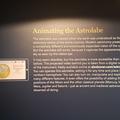Lines of Faith
In the creation of the heavens and the earth, in the revolving of night and day, are signs for those with understanding.
Qur’an, 3:189–190
Science: Circles and Stars
Celestial Globe, Indo-Persian?, c. 1700? (Inv. 47262)
Rete of a ?Syro-Egyptian Astrolabe, Syria?, Early 10th Century? (Inv. 48470)
Astrolabe, by Qassim `Ali Qa'inbi, Persian, 1682 (Inv. 45509)
Astrolabe, by `Abdi, Turkish, 1713/14 (Inv. 39955)
Art: Heavenly Beauty
Astrolabe, by Muhammad Mahdi al-Yazdi, Persian, c. 1660 (Inv. 46886)
Astrolabe, Persian, 17th Century (Inv. 54607)
Craft: The Mindful Hand
Astrolabe, Indo-Persian, 17th Century (Inv. 33411)
Astrolabe, Guadalajara, 1081/2 (Inv. 52473)
Astrolabe Template, Persian, 18th Century? (Inv. 52332)
Religion: Astronomy in the Service of Islam
Astrolabe, North African, Early 18th Century? (Inv. 34314)
Qibla Indicator, 18th or 19th Century (Inv. 43695)
Astrolabe, by Muhammad Mahdi al-khadim al-Yazdi, Persian, c. 1650 (Inv. 41763)
Animating the Astrolabe
The astrolabe was created when the earth was understood as the stationary centre of the entire cosmos.
Modern astronomy presents a completely different and enormously expanded vision of the universe. But the astrolabe still works, because it captures the appearance of the sky as seen by the naked eye.
It may seem obsolete, but the astrolabe is more accessible than ever before.
This animation was created by Dr Stephen Johnston from a digital version of the instrument, freely available online.
https://www.youtube.com/embed/0wVcG6dOXB0
On the website you can operate this astrolabe, setting it for any time and place in the northern hemisphere. You can also turn on, manipulate and explore its many different features. It even offers the possibility of adding the exact positions of the Moon and the other classical planets (Mercury, Venus, Mars, Jupiter and Saturn) – just as ancient and medieval astronomers dreamed of doing.












